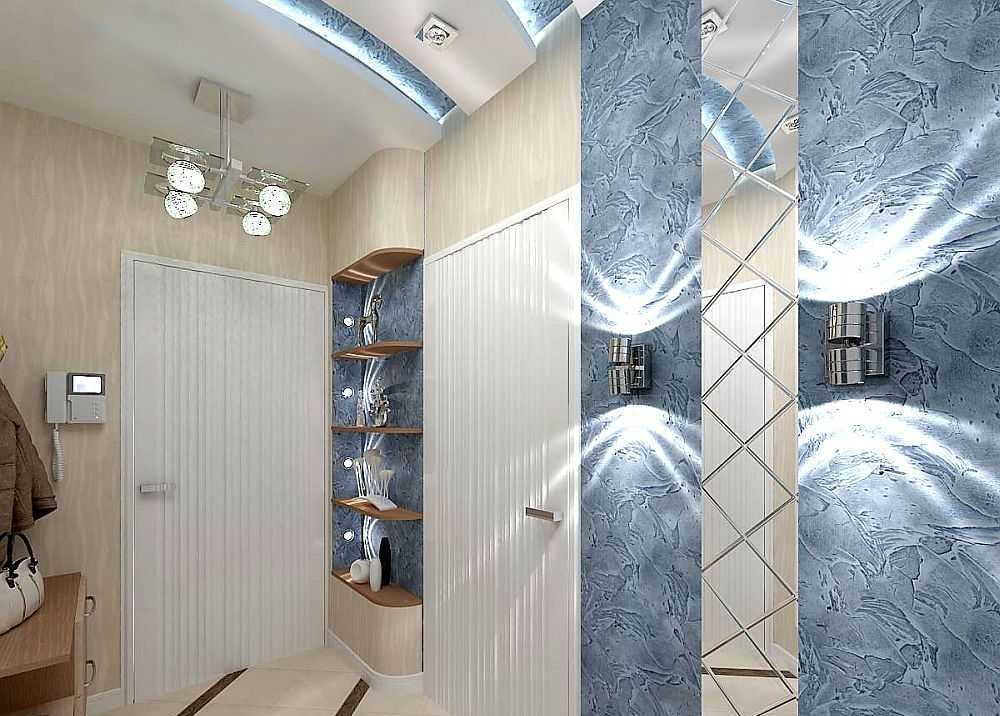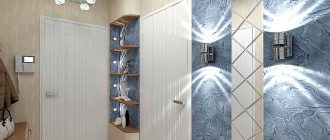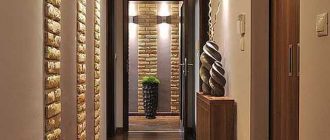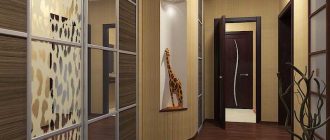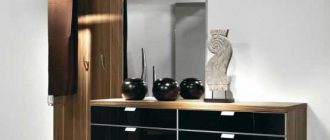The hallway and corridor are rooms that should make an impression, as they are the first thing a person sees when entering your home. They should also be comfortable, because they are where people dress and get dressed. Both beauty and convenience are possible only in one case, if the lighting of the hallway is selected correctly and provides a sufficient level of illumination.
Artikkelens innhold
Tekniske aspekter
Illumination in each room of the house is normalized by SNiP. According to its recommendations in the hallway and corridor for each meter of area should be 50 Lm of light flux. In this case, everything is calculated simply: calculate the area of your room (if there is a closet, it does not count). You multiply this figure by 50 Lm and get the luminous flux that all the lamps should give.
For example, the hallway has dimensions of 2,5*1,8 meters. Its area is found by multiplying the figures among themselves: 2,5*1,8 = 4,5 m2. Then find the light flux according to the norm: 4,5*50 = 225 lux. That is, all the bulbs that we install in this corridor should give illumination of at least 225 lux. It is such (or more) light flux should have a hallway lighting.
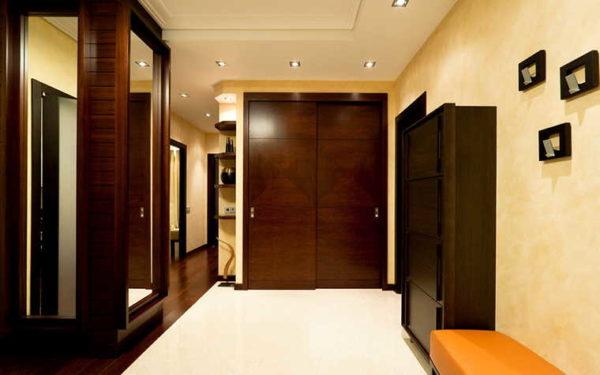
There is one more technical subtlety that will make life more convenient and pleasant. Usually the light switch in the hallway is located near the door. If it is small, this state of affairs is quite tolerable – a couple of steps can be made in a poorly lit space. In a long hallway or corridor it is very inconvenient. You turn off the light and walk in the dark. In the daylight hours is still more or less, but in the evening or at night to wander in the dark is not too pleasant. You can remedy this situation by installing pass-through switches, which allow you to turn on and off the light from several points. For example, place one near the front door and another near the door to the room and/or kitchen.
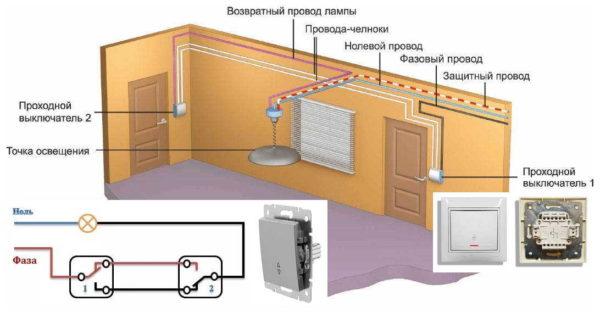
It is especially convenient to use a pass-through switch in a long corridor. Turn on the light near the entrance, walk along the lighted corridor, turn it off near the room. And vice versa: turned on at the room, dressed, leaving, turn off. Convenient, and in addition, the lighting of the hallway will also be economical, as there is no need to leave the lamps on.
If there is a closet or dressing room in the hallway, their lighting is done separately. For dressing rooms even has its own norm – 75 Lm per square meter of area. As light sources, it is better to use LED lamps – they emit the least amount of heat, and shine brightly.
There is another opportunity to save on lighting bills and do not infringe on the convenience of use – put motion sensors. They will only turn on the hallway lighting if someone is in the room. The only difficulty may arise if the corridor has a curved shape: you will have to put two sensors and direct them in different directions.
Types of chandeliers for hallways
The specificity of the hallway very rarely allows you to use large chandeliers – it is too small rooms. In them it is necessary to dress/dress, which requires a certain freedom of action. Therefore, lamps for the hallway choose compact, not too far from the walls or ceiling. And this is the main criterion. The second is the number of lamps. Most often choose with one, maybe even with two. A larger number in a small space is unnecessary. Unless the entire hallway to install only one lamp. But more often the lighting of the hallway is made multi-component. At a minimum, use a few more wall lamps near the mirror.
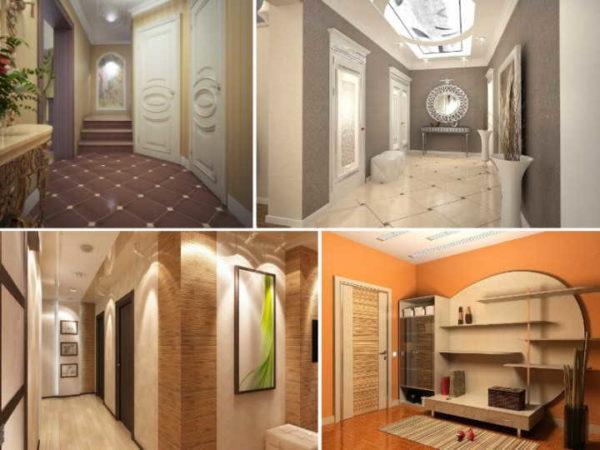
Here are what lamps for can be considered for the hallway:
- Ceiling flat or with a very small height. In shape – any – round, square, long.
- Wall lamps – wall sconces of various configurations.
- Built into the ceiling point.
- LED illumination of the ceiling or any objects.
The latest trend in lighting – a combination of backlighting (LED strip or built-in lights) with ceiling lights and sconces. Lights are placed evenly across the ceiling area, sconces are usually near the mirror or above the chest of drawers.
How to position the lamps
Knowing how much light the lamps should emit is not enough. It is still necessary to choose the right location. Correctly – it is so that it was beautiful, the light fell evenly and the lights do not interfere with the movement.
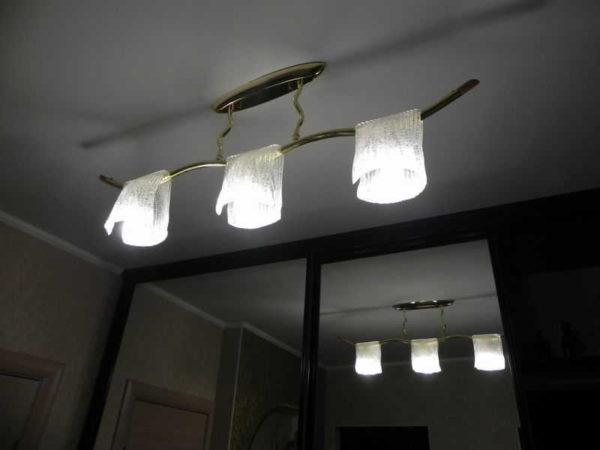
Only wall lighting: worth it or not
When developing schemes for lighting the hallway come different ideas. One of them – to abandon the ceiling lighting, installing only wall lights. In principle, it is possible, but the result is unlikely to please you: with the help of sconces even lighting is not achieved. There will be clearly visible dark and light areas. It looks great on the picture, creates a pleasant visual effect, but it is impractical and inconvenient. When you have to get dressed, there’s not enough light, it’s annoying. But that’s a subjective feeling. You may be happy with uneven light, or you may have a lot of mirrors in your hallway that reflect and diffuse light.
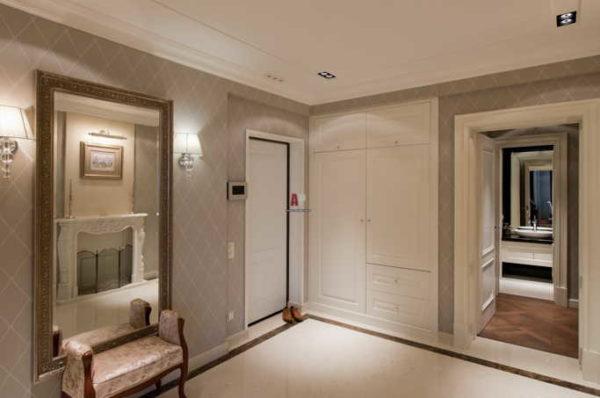
To check how much you like wall lighting in the hallway can be in practice – to conduct an experiment. Find a few flashlights of any type, attach them with painter’s tape in places where the lamps are supposed to be installed. If there are some old sconces, you can use them. They will give a more believable picture (flashlights usually give too narrow a beam of light, but you can remove the reflector, leaving only the bulb).
Once you have installed the temporary wall “lights”, use only these “lights” for a couple of days. This way you will be able to understand whether you have enough light only from the sconces, or still need ceiling lighting. This technique, by the way, you can use and if you are looking for where to fix the lights in the hallway, hallway, and in any other room.

If you do not want to have ceiling lighting in the hallway, there is a way out. You can find wall-mounted downlights that direct the entire light stream upward. The light reflected from the ceiling will be dispersed more evenly. But to implement this plan, you need to fulfill a few conditions. First – the ceiling must be perfectly white. It is better if it is glossy or semi-glossy, and this is a stretch ceiling. Second – the light flux from the lamps should be 1.5-2 times more than normal. Then you can hope that the reflected light will be enough.
Ceiling lights
Ceiling lights for hallways and corridors can be of several types:
As you can see, there are many possibilities to make ceiling lighting and it is not necessary to use chandeliers. When choosing where to install lights on the ceiling in the hallway, are guided by the size and geometry of the room. If the room is square or close to this form, it makes sense to place the chandelier in the center. In a room more like a rectangle, you can put two or three ceiling lights, dividing the length into equal sections.
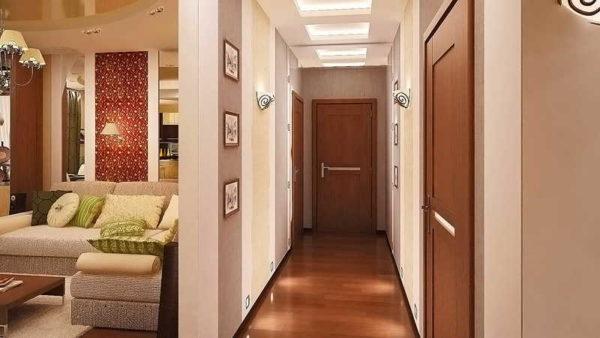
If the shape is irregular (usually in the form of a letter G or T), one of the light sources is placed at the branching point of the corridor. If the “appendix” is small, this is enough. If the distance is more than 2-3 meters, you can put one additional light.
LED lighting in the hallway and corridor
LED strips are good in that they can be mounted both on the walls and on the ceiling. On the ceiling backlighting is usually done around the perimeter – at the junction of the wall and ceiling or specially made box. On the walls LED backlighting looks good in niches, near the mirror, decorative objects or paintings.

It is used mainly as additional lighting, to create a decorative effect. There are LED strips that are able to change color, and the brightness of the glow they can change everything. So they can work instead of nightlights, creating a comfortable environment at night.
Connecting LED strips has its own specifics – basically, they work from a constant voltage of 12 or 24 V. For inclusion in 220 V, adapters are required.
Light as a means of correcting proportions
The hallway and corridor often have an unfortunate shape. The room can be long, narrow, cramped. These imperfections can be corrected with lighting. Here are some standard situations and ways to solve them:
These tricks really work and solve two problems at once: illuminate and correct the shape of the room. You just have to choose the right light sources.
The best hallway lighting
The hallway and corridor are both passageways and functional rooms. Optimal option when lighting here is multi-component and multi-level. Most often, it is made of a composite: general – ceiling and spot – zoned. This approach provides a high level of comfort. If you need to dress and assess your appearance, you turn on all the lights. With bright lighting, no detail will slip away. If you need only “duty” light, turn on one or two bulbs. Enough to dispel the darkness and economical, as there is no overconsumption of electricity.
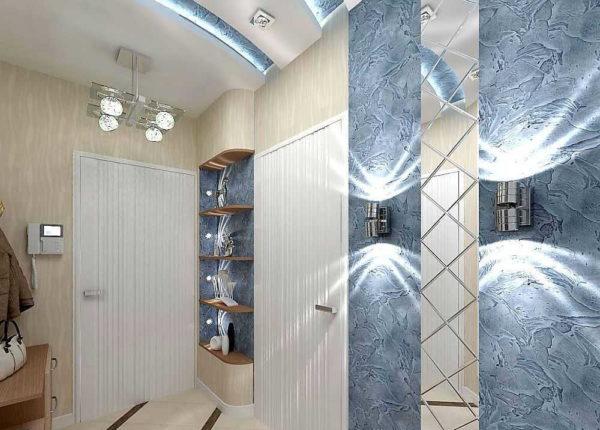
Spot lighting is located near the mirror, closet (or in the closet itself), sometimes – near the front door. Here install sconces or spots – overhead lights with a rotating plafond. They should be switched on separately from the ceiling lighting. Spots are also convenient on the ceiling – you can always change the direction of the light flow. In this case, there is no need to rearrange the lamps – you just need to turn the plafonds.
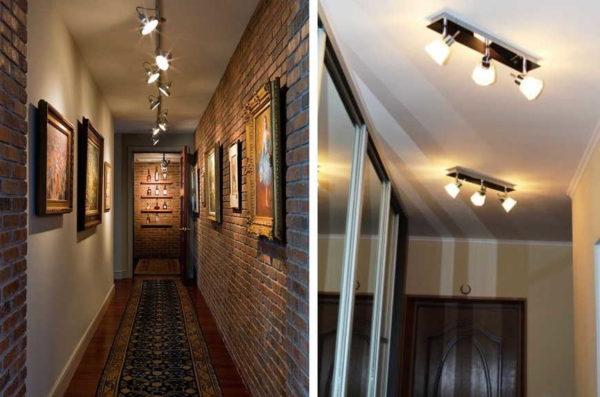
Light switches in the corridor or hallway are located near the front door, on the “additional light sources” – near mirrors, cabinets – most often, not far from them.

